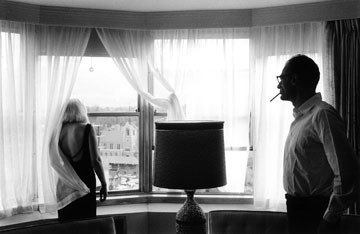Inge Morath: The Road to Reno
September 10 – December 10, 2007

in Reno's Mapes Hotel after a day's shooting.
© Inge Morath Foundation/Magnum Photos, 1960
The Albin O. Kuhn Library Gallery presents Inge Morath: The Road to Reno, featuring approximately 70 photographs by the Austrian-born Inge Morath. An early member of the Magnum agency, Morath traveled extensively in Europe, North Africa, and the Middle East. Her special interest in the arts found expression through photographic essays published by a number of leading magazines. After her marriage to playwright Arthur Miller in 1962, Morath settled in New York and Connecticut. She made her first trip to the USSR in 1965, and in 1978, after studying Mandarin for five years, she made the first of many trips to the People's Republic of China together with Miller.
The Road to Reno is a document of an 18 day trip across the United States, from New York City to Reno, Nevada, made by Inge Morath and Henri Cartier-Bresson en route to the set of the film The Misfits in 1960. Developed by Arthur Miller into a screenplay from a short story that he had written, The Misfits was an "offering" to actress Marilyn Monroe. In 1958, Miller presented the script to John Huston, who had earlier worked with Monroe in The Asphalt Jungle, and he agreed to direct the film. Clark Gable, Montgomery Clift, and Eli Wallach signed on as the film's co-stars, and producer Frank Taylor signed an exclusive contract with Magnum Photos to document the making of the film.
Photographers Henri Cartier-Bresson and Morath were the first of nine photographers selected to work on the set of the film. It was Morath's first trip across the US, and they followed a southern route drawn on a map in red grease-pencil by Cartier-Bresson, through Pennsylvania, Tennessee, Texas, New Mexico, and California before heading north to Nevada.
The exhibition focuses on Morath's encounter with America, and includes a selection of photographs made on location in Reno during the filming of The Misfits. The exhibition is accompanied by excerpts from Morath's journal and caption books, as well as an essay by Arthur Miller. Morath's photographs and texts, Miller writes, "are so wonderfully observed and at the same time charmingly naive, as she was still fresh in her American experience."